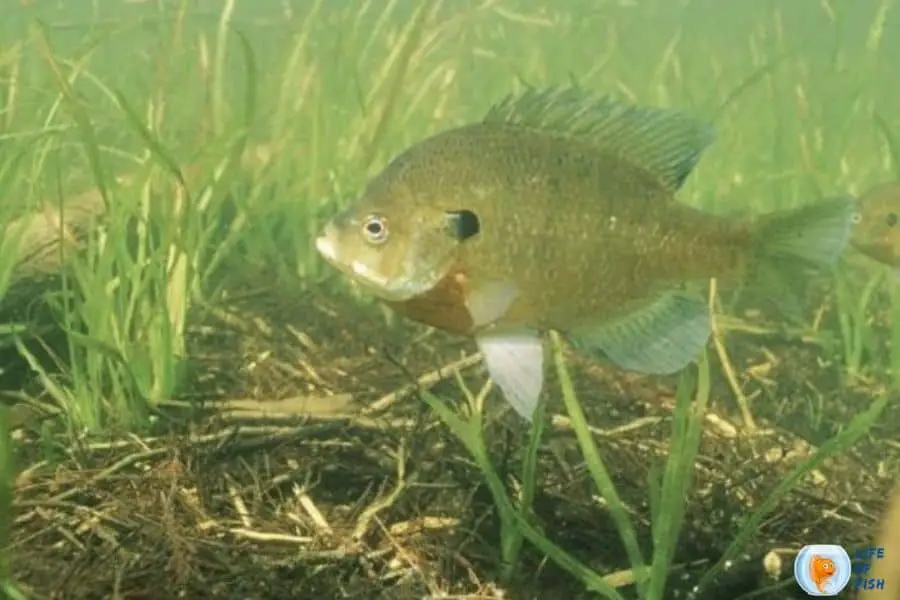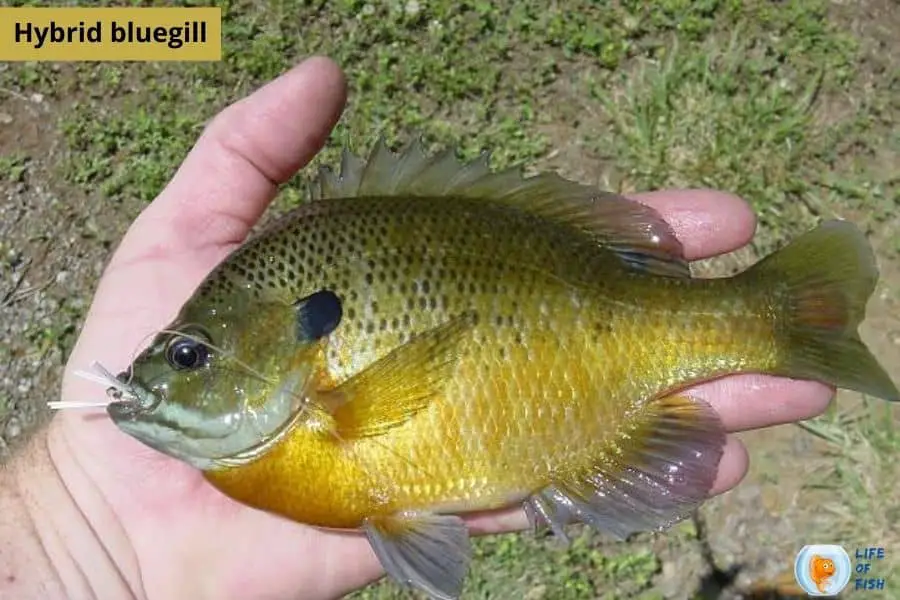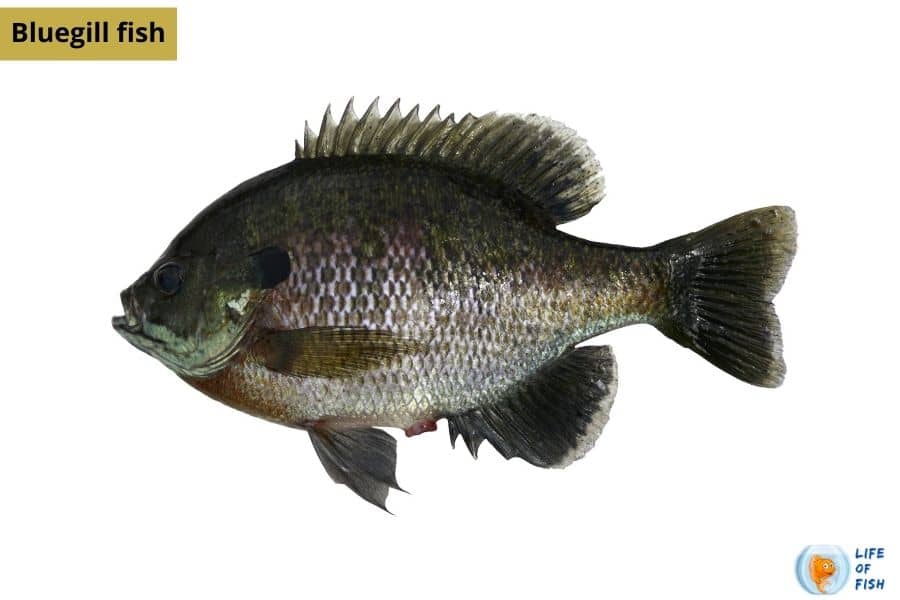Bluegills Hybrid are one of the most sought-after freshwater fish for small ponds. And that’s for several reasons. It is easy to keep, pretty, and has the most bang for the buck.
So, isn’t it Bluegill? Yes and No. As the name suggests, Hybrid bluegill is a hybrid. Not true, Bluegill. Want to know more? Then read this article.

What is hybrid Bluegill?
Jump To
- 1 What is hybrid Bluegill?
- 2 What does hybrid Bluegill eat?
- 3 What does hybrid bluegill look like?
- 4 How can you tell hybrid bluegill?
- 5 How big will hybrid Bluegill get?
- 6 What is the lifespan of hybrid Bluegill?
- 7 Are hybrid bluegills sterile?
- 8 Can hybrid Bluegill reproduce?
- 9 Are hybrid Bluegills good to eat?
- 10 Hybrid bluegill stocking
- 11 How do you catch hybrid bluegills?
- 12 When do hybrid bluegills spawn?
- 13 Related Questions
- 14 Conclusion
They are hybrid between a male bluegill and a female green sunfish. It is sometimes referred to as hybrid sunfish.
What’s unique about this hybrid is that these fish grow fast and usually don’t reproduce as bluegills.
This hybridization occasionally occurs in the wild, but the specimens available in the market are man-made.
Most of them are bred in fish hatcheries and the pond stocking industry.
Hybridized bluegills are usually more aggressive than bluegills because over 90% of specimens are male.
Because of this, the reproduction rate of hybrid bluegills is much lower than bluegills or sunfishes, making them the perfect choice for smaller ponds.
They are carnivore fish and have a non-picky appetite. They eat a lot of insects, and this is one of the primary reasons why people love to keep them in ponds.


What does hybrid Bluegill eat?
In general, they are pretty much opportunistic fish that won’t turn down any type of food.
They love having crickets, earthworms, minnows, crawfish, and other aquatic insects in their diet. They will also eat commercial fish food and pellets.
What does hybrid bluegill look like?
They have a long, greenish color, oval, and laterally compressed body with hot-orange rimmed fins.
Their average size is about 10 to 12 inches. They have a larger mouth and are slightly larger than bluegills.
How can you tell hybrid bluegill?
Although they have almost similar characteristics to Bluegill, both species have distinct differences.
Appearance-wise, hybrid bluegills are slightly larger than bluegills. Their body color is different than bluegills.
Bluegills are deep blue to purple on the upper body, while hybrid bluegills have a more greenish color.
They have yellow margins on their fins, but bluegills lack these color hues in the fins.
Thier mouth is five times larger than Bluegill, which makes them more efficient eaters than bluegills.
They grow faster and larger than bluegills. This is one main reason for pond owners to choose hybrid bluegills over bluegills.
They reach about 8 inches within one year and sexually mature months before when they reach 5 inches.
Bluegills take more time to plump up ad sexually mature, but eventually, bluegills win over the crowd size of the pond because of their excessive reproduction rate.
Behaviour-wise, hybrid bluegills are more aggressive than bluegills. They are voracious eaters that eat five times more than bluegills.
They do reproduce, but as the female population is less than 10% and the offspring has more males than females, their population goes down to zero eventually.
On the other hand, bluegills have a crazy reproduction rate. These fish reproduce in the mid-late Spring to the early summer.
They reproduce excessively, which leaves us the extra hassle of controlling the population by taking necessary measures.
Most of them are sterile from birth. So, you can not expect much offspring or any second generation at all with hybrid bluegills.
This is actually a benefit for small ponds because the space is limited in the small ponds.
How big will hybrid Bluegill get?
They will grow slightly larger than Bluegill.
On average, bluegills grow up to 7.5 inches maximum (but that can vary due to food supply and water conditions).
Usually, this fish grow more than 8 inches on average.
What is the lifespan of hybrid Bluegill?
They usually live more years than Bluegill.
The average life span of hybrid Bluegill is about 6 to 8 years. On the contrary, bluegills live only for about 5 to 6 years.
However, this life expectancy can change due to the water condition levels of their habitats and the amount of food supply.
Like straight bluegills, these fish also do well in cool to warm waters, which increases their life span.
Are hybrid bluegills sterile?
Hybrid bluegills are mostly sterile. Further, more than 90% of hybrid bluegills are males. However, there can be some fish that can reproduce.
Those who can spawn will actually reproduce. But, the offspring will be primarily male, or most of them will be sterile.
Can hybrid Bluegill reproduce?
Hybrid bluegills can reproduce. But, most specimens will be either male or sterile, which makes their reproduction rate dramatically lower than other fishes.
Since the offspring will also have about 90% male specimens, their reproduction rate drops to zero after about 3 to 5 years.
Hybrid Bluegills are a result of breeding between a female green sunfish and a male Bluegill.
Hybrid bluegills share many of the same traits as their parents, but they also have some unique traits.
As they breed, the hybridization diminishes, and the unique features lose.
By the third or fourth generation of hybridized offspring, the species reverts back to the similarities of its parents.
They lose their unique growth size and characteristics and revert back to Green Sunfishes.
Are hybrid Bluegills good to eat?
Yes. Hybrid bluegills are good to eat because they taste exactly like straight bluegills.
What’s better is that you get a bigger fillet with hybrid bluegills than bluegills. Hybrid bluegills also have a delicate flavor in tender, firm, and flaky meat.
Hybrid bluegill stocking
Hybrid bluegills are popular as stocking fish in North America.
In fact, they are considered the best choice for small ponds because of their fast growth rate and their low reproduction rate.
Since they also have a taste similar to bluegills, people love to eat them. They are also a popular sport fish for fishing tournaments.
However, there are crucial facts to consider before choosing these fish for your pond.
For example, they can out-compete native sunfish species and are very aggressive towards small fish, reducing the native population.
So, if your pond already has other sunfish species like regular Bluegill, redear sunfish, and black crappie, stocking hybrid Bluegill won’t be a good choice because they can compete with these species for food. This can result in stunted fish populations.
The Hybrid Bluegill is not an ideal choice for bass forage, contrary to popular belief.
In reality, Bluegill is a far superior choice for bass forage because of its controlled growth rates and long-term viability.
Hybrid bluegills are best suited for species only ponds or when there is a very limited number of competing fish species.
Hybrid Bluegills are a type of fish that are often stocked in old farm ponds, man-made fishing ponds, or derby ponds for kids.
These ponds are usually built with fish feeders or any other commercial feed operation, which helps to keep the fish population vigorous and thriving.
How many fish can you have in a 1-acre pond?
Generally, you can have about 300 to 500 hybrid bluegills in a 1-acre pond. This amount is lesser when you stock bluegills because they continue to reproduce.
You can accumulate more hybrid bluegills in your pond as they do not breed much, and their population diminishes as you catch them.
If you plan to keep a stable hybrid bluegill population in your pond, you will have to restock about 30 to 50 percent more within 2 to 3 years’ time. This can replace the harvested amount annually.
How much does it cost to stock a pond with hybrid Bluegill?
On average, hybrid Bluegill will cost you around $0.50 to $2 per fish.
So, if you plan to stock a 1 acre with 300 fish, it will cost you around $150 to $600. For 500 fish, it will cost you about $250 to $1000.
You may be able to get a discount if you buy in large quantities. So, the cost to stock a pond varies by the size of the pond and the fish amount you plan to store.
What do you feed hybrid Bluegill?
Hybrid bluegills are voracious eaters. Therefore, they require more food to thrive.
You can stock small freshwater fish species like Fathead Minnow and Golden Shiner for your hybrid bluegills to prey on.
Even though you stock your pond with small fish species, they may not be enough for your fish.
Therefore, you may have to feed them with commercial food like fish pellets and flakes. Additionally, they will also feed on insects, worms, crawfish, and mollusks if they are available.
How fast does hybrid bluegill grow?
Hybrid bluegills will take around one year to grow about 8 inches and a maximum of 2 to 3 years to reach their maximum length.
They can get more than 10 to 12 inches when fully grown. So, as you see, they are very fast-growing fish.
However, these numbers can change if they don’t get adequate amounts of food. They require consistent feedings as well as supplemental feeding operations to thrive.
If they receive enough feedings daily, they can grow twice as fast as standard Bluegill.
If the growth rate is documented by weight, hybrid bluegills will plump up to 1/2 to 3/4 pound per season with regular feedings and supplements.
How often do I need to restock hybrid bluegills?
Even if you don’t fish for these fish, you will have to restock about 2 to 3 years after initial stocking if you intend to keep a stable population in your pond.
If you harvest these fish occasionally, experts recommend about 30 to 50 percent restocking every three years.
When you restock hybrid bluegills, you will also have to restock minnows and shiners.
Experts recommend about 25 to 50 pounds of minnows per acre each time you restock hybrid bluegills.
You will also have to restock minnows if you don’t see any minnows swimming the shoreline and bluegills searching for food.
How do you catch hybrid bluegills?
Fishing for hybrid Bluegill is not much different than fishing other types of sunfish.
You can use light tackle lines, small hooks, and live bait or lures like micro-grubs jigs soft baits to catch them, in the same way, you would if targeting bass, crappie, and panfish – it just takes practice!
Hybrid Bluegill is not afraid to hit the bait on the surface. It’s an easy fish for anglers who like using topwater or fly techniques, and they’re lots of fun in close proximity.
Recommended baits for hybrid bluegills are red worms, mealworms, and fathead minnows. You may be able to catch overly aggressive fish with small artificial lures in the Spring.
With extremely aggressive fish, you will get quite a fight, making your fishing more fun!
When do hybrid bluegills spawn?
Hybrid bluegills are in the full breeding mode from May to mid-June as the weather starts to warm up and water temperatures reach 65-85̊F.
They construct nests 1 to 4 feet deeper in the water like other sunfish species.
With males being overrepresented, there’s not a lot of reproduction happening during this season.
Further, the offspring may not be the same quality, steriale, or completely green sunfish as hybridization diminishes as they reproduce.
Related Questions
Are Bluegills healthy to eat?
Bluegill is a species of sunfish, and all sunfish species are edible.
Although bluegills are considerably smaller than other sunfish species, people love these fish because of their rich, delicious taste.
Apart from the taste, bluegills are considered healthy because of their nutritional value.
Generally, three ounces of Bluegill have about 97 calories, 1.3mg iron, and two micrograms of vitamin B12.
Additionally, it is rich in protein and low in cholesterol and carbohydrates. They also have a fair amount of Omega 3 fish oils, which are suitable for the heart.
With all these benefits, it’s no wonder that bluegills are one of America’s favorite panfish!
Do bluegills have parasites?
Like many other ponds, lakes, and river fish, bluegills may also have parasites. The most common parasites infected are flukes (grubs).
Flukes are flatworms that grow on the inner surface of the gill.
Flukes enter the digestive tract and absorb nutrients directly into the bloodstream. They may also get into open wounds or skin abrasions that can be caused while handling infected fish.
When you see a white worm protruding from the gills or anus of a fish, the fish is likely infected with flukes.
Infected fish may lose weight, have a poor appetite, and show signs of distress. If you suspect that your fish are contaminated with flukes, you should take the necessary steps to stop spreading the disease.
Flukes are also contaminated in humans. Therefore, it is necessary to cook bluegills well before eating.
Parasites are killed at a temperature of 140 degrees Fahrenheit. Freezing also kills parasites but may change the flavor of the fish.
Conclusion
Hybrid bluegills are a great addition to any pond. They are easy to catch and provide plenty of fun for anglers.
Spawning occurs in May to mid-June, so be sure to get out there and try your luck!
In addition to being delicious, hybrid bluegills are also a healthy source of protein and omega-3 fatty acids. So grab your rod and reel and get ready for some action!
Read Next : Bluegill Vs. Sunfish | 12 Facts To Avoid Your Confusion|
